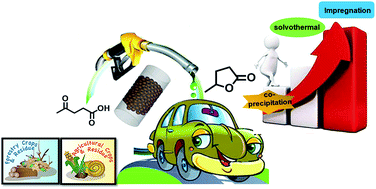Unraveling the structural properties and reactivity trends of Cu–Ni bimetallic nanoalloy catalysts for biomass-derived levulinic acid hydrogenation†
Abstract
Herein, we have developed a series of silica nanosphere supported CuNi bimetallic nanoalloy catalysts via solvothermal, impregnation and co-precipitation methods and evaluated their catalytic performance for the hydrogenation of levulinic acid, a key platform molecule in many biorefinery schemes, into γ-valerolactone. Different characterization techniques including powder X-ray diffraction (PXRD), high resolution transmission electron microscopy (HR-TEM), X-ray photoelectron spectroscopy (XPS), solid state 13C CP MAS NMR, and field emission scanning electron microscopy (FE-SEM) with the corresponding elemental mapping have been employed to evaluate the compositional and structural features of the silica nanosphere encapsulated Cu–Ni bimetallic systems. The resultant catalyst asdeveloped by an impregnation method presents enhanced catalytic performance compared with other catalysts, providing 99.3% conversion of levulinic acid with 96.8% selectivity of γ-valerolactone in 13 h at 120 °C. Comparing catalytic experiments between bimetallic Cu–Ni and monometallic Cu catalysts demonstrated that the outstandingly improved catalyst activity and stability could be ascribed to the modulation of the electronic properties of the active sites and inhibition of metal particles with the introduction of another metal promoter, with good recyclability after ten recycles without notable loss in the activity. Our investigation in this study sheds light on a new insight into the structure–performance relationship of the bimetallic Cu–Ni nanoalloy phase in the low cost liquid fuel production from biomass.



 Please wait while we load your content...
Please wait while we load your content...